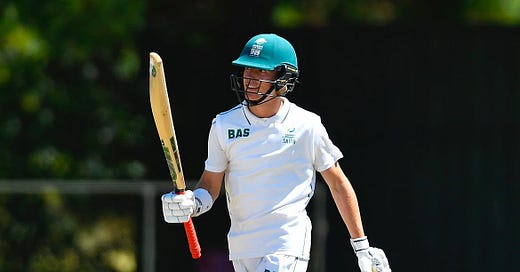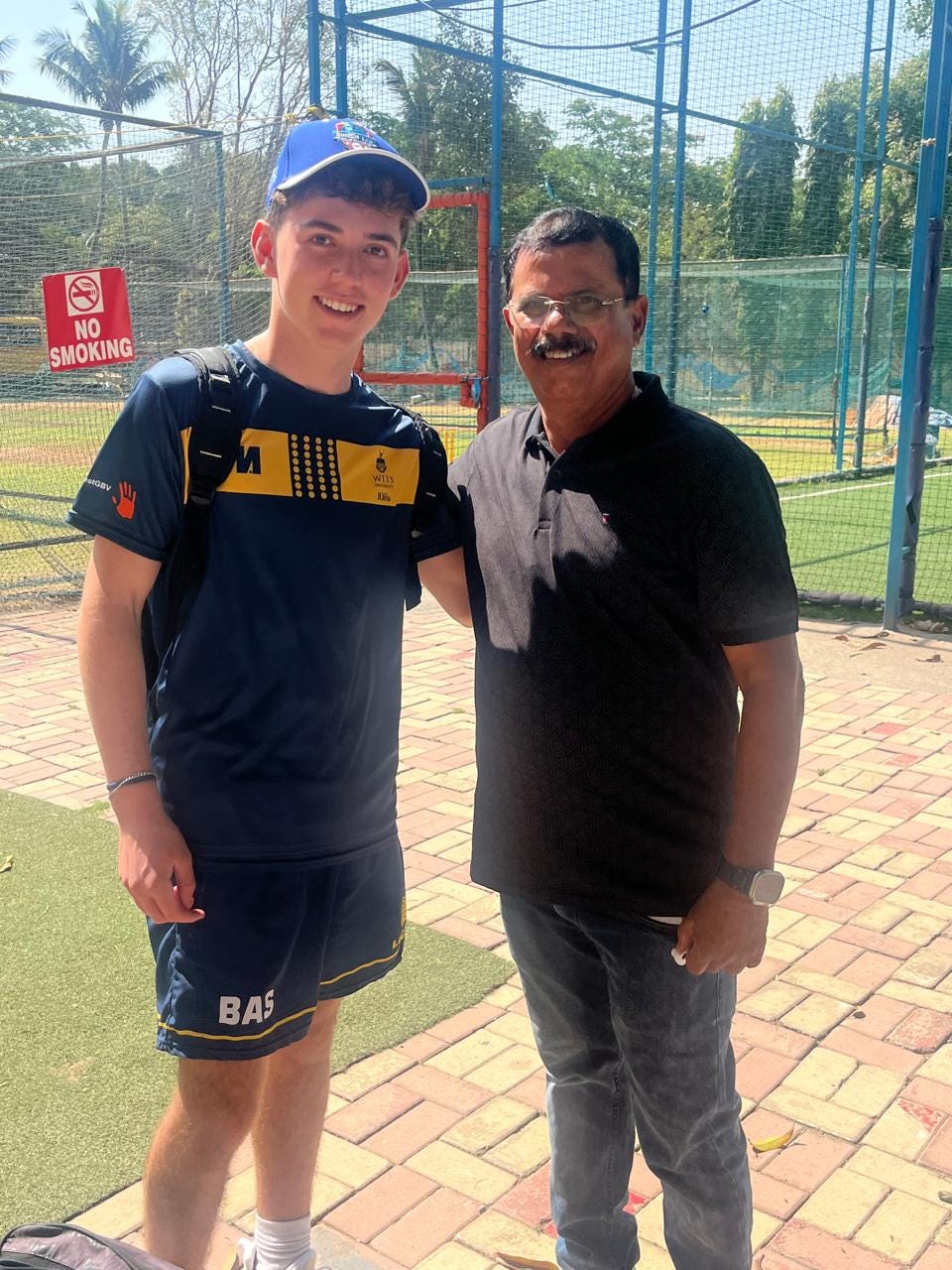Meet Jason Rowles. There is a lot to like about his game and even more about him as a person.
Jason Rowles bunted the ball to the fielder at cover. He did so with the confidence of a batter who had been out there for a while, had a good measure of the pitch, and knew what the bowler was doing. However, Rowles hadn't been at the crease for long. That was the first delivery he faced.
"Most batters are nervous and unsure early on and need a few overs to settle. Not Jason. He looks at home the moment he walks out there," Malibongwe Maketa, South Africa's u19 coach, shared.
Rowles makes batting look so easy that one forgets that he is only 16. The second delivery was on the same line and length. Rowles addressed it accordingly. Farhan Ahmed was asking questions; and the third one was a full-length leg break. Rowles helped it on its way past the slip cordon and took two runs to get off the mark.
74 deliveries after the two runs, Rowles guided the ball into the third man region for another two runs. This brace took him to 50. He had faced a total of 77 deliveries to reach a half-ton. It was the first of three half-centuries in four innings across two Youth Tests against England u19.
Rowles navigated England’s varied spin attack and aggressive pacers in tough windy Stellenbosch conditions on his way to a brilliant 90 off 118 deliveries.
“That 90 is one of my favourite performances ever. It was great learning and a good challenge against a high-quality attack,” Rowles shared.
Everyone with their ears to the ground felt the plate tectonics shift beneath them in 2008. An era was coming to an end. Players who made their name in the 90s and dominated the early 2000s were bowing out. Brian Lara retired in 2007, Sachin Tendulkar, Sourav Ganguly, Adam Gilchrist, Stephen Fleming, Matthew Hayden, among others, called it quits in 2008. The ones that stuck around left shortly afterwards.
The most important change came with Brendon McCullum clubbing an unbeaten 158 off 73 balls in the first-ever IPL match. His knock was the fireworks needed to launch the format. The ECB introduced the format in 2003, but no one had taken seriously. In 2008, the BCCI and money from major businesses gave it the gravitas it needed to take over world cricket.
In South Africa, a young family welcomed their first child. They called him Jason. Some cultures believe that talent skips a generation. Jason Rowles' maternal grandfather, Erwin Kretschmer, was a bowler. He took the new ball for Border Schools and East London Technical College.
However, a six-day working week left Kretschmer with no time to practice or play. Cricket wasn’t a career in the 1960s, so he focused more on regular employment and neglected the sport.
Rowles is a child of the age of cricket globalisation. He grew up in the T20 era where everything is compressed. There is less time for bowlers to set traps or batters to get their eye in. It is a sport where one has to make decisions on the fly. A trait that Rowles developed early.
Being the oldest child, Rowles did not have a sparring partner early in his life. Things changed after his younger brother, Sean, came along. However, before Sean’s arrival, his father, Robin, threw balls when he was asked and that was often every day. However, his father couldn’t throw at him daily or for as long as he liked, so Rowles created games that involved a bat and a ball that he could play alone.
Rowles used to plant cones in the backyard. They represented fielders and occupied positions he had watched teams employ on TV. He would bounce the ball at the wall at different angles to make his one-man game challenging. Hours flew by and he wouldn’t notice. When his parents switched the lights on late in the day, he would convert his match into a day-night encounter.
His game was a practice in placement; he tried to thread shots between cones. However, he never got tied down to batting to the same ‘field’ because he watched so much cricket.
“Jason has always been passionate about cricket. When the Proteas travelled to Australia or New Zealand, he woke us up early to watch cricket,” Robin shared.
Jason Rowles' 150 runs for the Wits Premier League A team. That is Bongani Ntini's favourite innings from the teenager. Rowles started playing up from the time he was nine when he turned out for United Stars. He scored several 100s, some of them daddy hundreds. However, this one was different. Ntini described it as a coming-of-age knock.
Ntini is one of the four people who make up the four pillars in Rowles’ life. The other three are Alex Shahim, Dave Nosworthy and Dinesh Lad. The quartet has helped Rowles develop structure in his cricketing journey.
“My job is to chauffeur the boys to where they need to be and to remind them to enjoy themselves when they play cricket,” Robin explained.
Ntini has been in Rowles’ life from his days with United Stars. Coach and student moved to Wits after Ntini transferred. Rowles was a top-order batter who bowled seam when he showed up for his maiden session with Ntini. The teenager suffered a couple of injuries and had to switch to spin.
Rowles had a solid front foot defense and possessed a potent cover drive. Ntini introduced drills that put him on the back foot. "He had a good technical grounding and could occupy the crease for hours," Ntini shared.
Several years ago, Adam Gilchrist shared that his father helped him develop a solid technique and the aggressive strokeplay he built his reputation on as an international player was an extension of that base.
"We spent hours in the nets building from that foundation. We added shots to his repertoire. I think the most important thing was getting him to understand himself as a batter, his strengths and weaknesses," Ntini shared.
According to Ntini, one of their major talking points was for Rowles to back himself as a player and have no fear of expressing himself. Rowles expressed himself when he scored his maiden ton for Wits. Even more impressively, he didn't let his two previous single-digit scores for St David's Marist Inanda and Wits B dictate his approach.
That's the confidence Dinesh Lad, or more appropriately, Sir Dinesh Lad, saw when he viewed clips of Rowles batting. The Indian coaching maestro is viewed as one of India’s foremost talent whisperers. His extensive CV that features people like Rohit Sharma and Shardul Thakur among his students.
He runs an academy that takes in numerous Indian up-and-coming stars and a few select international youngsters each year. None of the students pay a fee towards Lad.
“When I first saw him bat, it was a wonderful vision. He has an in-born talent and just needed a small direction which impacted his whole game and Miracles for his overall career,” Lad shared.
A few months after their first contact and countless texts between Robin and Lad, father and son touched down in Mumbai, India, on Lad's invitation. It was a transformative trip for Rowles and his father. Robin experienced and learned about Indian culture. Rowles upskilled.
Each day, Rowles faced a battery of spinners for hours under Lad's watchful eye. Then there were the speedsters. The sessions were punctuated by drills to fortify Rowles' strengths and a few others to overcome his weaknesses. Lad also helps his students with the mental side of the game and his coaching doesn't stop the moment a student leaves the academy. The mentor checks in with Rowles almost every day.
Like Ntini, Lad did not seek to transform Rowles. Instead, he has built on what Ntini and the other coaches in Rowles’ career have done before him.
Mumbai is a hot and humid place, especially in the summer. Temperatures hover around the mid 30s and rise to 38 on the hottest days. Rowles and Robin were in Bengaluru in the middle of summer. The youngster changed shirts twice each afternoon during training. The heat and humidity didn’t seem to have an effect on Rowles. He turned up looking energetic each morning and remained engaged throughout the 6-hour session.
“He is forever looking for opportunities to get into the nets, and always finds someone to throw or feed balls to him, even if it is for 5 minutes,” Jeff Levin, Rowles’ coach at St David’s Marist Inanda, shared.
In 2017/18, Steve Smith achieved the second-highest ranking points in Test cricket ever. He amassed 947 rating points. Only Don Bradman’s 961 is higher. Smith has always been supremely talented, but he didn’t scale that mountain on the back of his talent. It had more to do with his dedication to training. Few batters can claim to have hit the same volume of balls in the nets as Smith.
“My favourite international player is Steve Smith. He has a great work ethic. He is always the first to go into the nets and last to go out, just like myself,” Rowles shared.
Despite being lauded by many as talented, Rowles refuses to ride on his talent. Ntini recalled that Rowles sent him a text just before he boarded the plane from India to return to South Africa. The 16-year-old wanted to book a training session for the next day.
"He was doing six-hour sessions a day and he wanted to hit to hit the ground running when he got home. I told him he needed to rest," Ntini recalled.
However, his endurance and hunger to bat are not his best attributes. One of the first things Malibongwe Maketa and his high-performance team do is to gauge a batter's breaking point. Maketa has a strong arm and can throw at speeds up to 140 kmph. Most u19 batters get visibly distressed as speeds rise to the 140-mark. According to Maketa, that was not the case with Rowles.
"He did not look uncomfortable facing my highest speeds," Maketa explained.
Growing up in the highveld, where balls fly, is in part the reason why. Robin also exposed the teenager to high-pace by allowing Rowles to play up. His coaches, Ntini and Lad, used that as a platform to build his capacity to handle high-pace. If anyone was at the risk of feeling discomfort, it was Maketa's arm from overuse.
According to Maketa, when you combine Rowles’ ability to face high-pace and his attacking strokeplay against spin, you have an outstanding young batter. While those qualities set Rowles apart from his peers, Maketa feels the teenager’s coachability sets him apart.
"Our u19 players get a lot of input from school, provincial and private coaches. Most of them get stuck because they don't know what to do with all that information," Maketa shared.
According to Maketa, Rowles' ability to sift what he needs and apply it to his game puts him on a different plane. The high-performance coach points to this as the reason why the 16-year-old has more runs, at a healthier strike rate, than other players competing for u19 slots.
"We don't just look at the runs scored. We dig deeper. We consider the quality of the opposition and the state of the pitches. Jason Rowles’ stats were way ahead," Maketa explained.
Steve Smith is one of the best problem-solvers in the game. He is also one of the most adaptable players to ever hold a bat. Rowles' career is still in infancy, however, one can already see the same traits peak through.






